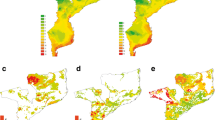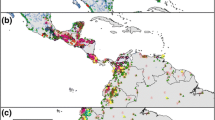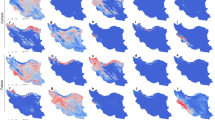Abstract
Snakebite envenoming is an important public health problem worldwide and addressing this issue has turned into a challenge for applied science. In this sense, the study of the distributional patterns of problematic snakes is central in terms of public health. Global Climate Change is affecting the distributional ranges of snakes, so that decisions regarding treatment of ophidism (poisoning by snake venom) may also change spatially and/or temporally. Here, we assessed suitable climate spaces at present conditions and estimated potential future changes in the distributions of the five southernmost venomous snakes, responsible for almost 99 % of accidents in Argentina, by implementing an ensemble of forecasts between different algorithms and scenarios for 2030 and 2080. Present suitable climate spaces showed high concordance with known distribution of the species. Future projections show moderate “north to south” displacements of the snakes’ suitable climate spaces, implying potential increments of suitable spaces in human populated areas in Argentina. Our results suggest the necessity of considering ophidism as a dynamic problem. In this regard, the analyses implemented here are useful tools in improving the assessment of snakebite envenoming in light of global climate change.





Similar content being viewed by others
References
Anderson RP, Lew D, Peterson AT (2003) Evaluating predictive models of species’ distributions: Criteria for selecting optimal models. Ecol Model 162:211–232
Araújo MB, New M (2007) Ensemble forecasting of species distributions. Trends Ecol Evol 22:42–7
Araújo MB, Thuiller W, Pearson RG (2006) Climate warming and the decline of amphibians and reptiles in Europe. J Biogeogr 33:1712–1728
Araújo MB, Rahbek C (2007) Conserving biodiversity in a world of conflicts. J Biogeogr 34:199–200
Bastos EGDM, De Araújo AFB, Silva HR (2005) Records of the rattlesnakes Crotalus durissus terrificus (Laurenti) (Serpentes, Viperidae) in the State of Rio de Janeiro, Brazil: A possible case of invasion facilitated by defororestation. Rev Bras Zool 22:812–815
Campbell JA, Lamar WW (2004) The venomous reptiles of the Western Hemisphere. Comstock, Ithaca
Carrasco PA, Harvey MB, Saravia AM (2009) The rare Andean pitviper Rhinocerophis jonathani (Serpentes: Viperidae). Zootaxa 2283:1–15
Carrasco PA, Leynaud GC, Scrocchi GJ (2010) Redescription of the southernmost snake species, Bothrops ammodytoides (Serpentes: Viperidae: Crotalinae). Amphibia-Reptilia 31:323–338
Carrasco PA, Mattoni CI, Leynaud GC, Scrocchi GJ (2012) Morphology, phylogeny and taxonomy of South American bothropoid pitvipers (Serpentes, Viperidae). Zool Scr 41:109–124
CIESIN, Columbia University, IFPRI, The World Bank, CIAT (2011) Global rural–urban mapping project, version 1 (GRUMPv1): Population count grid. NASA Socioeconomic Data and Applications Center (SEDAC), Palisades
Cruz LS, Vargas R, Lopes AA (2009) Snakebite envenomation and death in the developing world. Ethnic dis 19:42–46
Da Silva JN, Sites JW (2012) Revision of the Micrurus frontalis Complex (Serpentes: Elapidae). Herpetol Monogr 13:142–194
de Roodt AR (2009) Ofidios venenosos y sus venenos. In: Montero R, Autino A (eds) Sistemática y Filogenia de los vertebrados, 2nd edn. Tucumán, Argentina, pp 233–241
Di Cola V, Chiaraviglio M (2011) Establishing species’ environmental requirements to understand how the southernmost species of South American pitvipers (Bothrops, Viperidae) are distributed: A niche-based modelling approach. Austral Ecol 36:90–98
Diniz-Filho JAF, Mauricio Bini L, Fernando Rangel T, Loyola RD, Hof C et al (2009) Partitioning and mapping uncertainties in ensembles of forecasts of species turnover under climate change. Ecography 32:897–906
Dobrovolski R, Diniz-Filho JAF, Loyola RD, De Marco JP (2011) Agricultural expansion and the fate of global conservation priorities. Biodivers Conserv 20:2445–2459
Dokmetjian JC, Del Canto S, Vinzón S, De Jiménez Bonino MB (2009) Biochemical characterization of the Micrurus pyrrhocryptus venom. Toxicon 53:375–382
ESA (European Space Agency) (2010) Globcover 2009. Products Description and Validation Report.
Faleiro FV, Machado RB, Loyola RD (2013) Defining spatial conservation priorities in the face of land-use and climate change. Biol Conserv 158:248–257
Franklin J (2009) Mapping species distributions. Cambridge University Press, New York
Giraudo AR, Arzamendia V, Bellini GP, Bessa CA, Cinthia C et al (2012) Categorización del estado de conservación de las Serpientes de la República Argentina. Cuad Herp 26:303–326
Gutiérrez JM (2012) Improving antivenom availability and accessibility: Science, technology, and beyond. Toxicon 60:1–12
Gutiérrez JM, Williams D, Fan HW, Warrell D (2010) Snakebite envenoming from a global perspective: Towards an integrated approach. Toxicon 56:1223–1235
Hansson E, Sasa M, Mattisson K, Robles A, Gutiérrez JM (2013) Using geographical information systems to identify populations in need of improved accessibility to antivenom treatment for snakebite envenoming in Costa Rica. PLoS Neglect Trop D e2009
Harrison RA, Wüster W, Theakston RDG (2003) The conserved structure of snake venom toxins confers extensive immunological cross-reactivity to toxin-specific antibody. Toxicon 41:441–449
Hijmans RJ, Cameron SE, Parra JL, Jones PG, Jarvis A (2005) Very high resolution interpolated climate surfaces for global land areas. Int J Climatol 25:1965–1978
Hoss SK, Guyer C, Smith LL, Gordon W (2010) Multiscale influences of landscape composition and configuration on the spatial ecology of eastern diamond-backed rattlesnakes (Crotalus adamanteus). J Herpetol 44:110–123
IPCC (2007) Contribution of working group I to the fourth assessment report of the intergovernmental panel on climate change, 2007. Structure AR4:996
IUCN (2013) IUCN red list of threatened species. Version 2013:1
Joyner TA, Lukhnova L, Pazilov Y, Temiralyeva G, Hugh-Jones ME et al (2010) Modeling the potential distribution of Bacillus anthracis under multiple climate change scenarios for Kazakhstan. PloS one 5:e9596
Kasturiratne A, Wickremasinghe AR, De Silva N, Gunawardena NK, Pathmeswaran A et al (2008) The global burden of snakebite: A literature analysis and modeling based on regional estimates of envenoming and deaths. PLoS Med 5:1591–1604
Lafferty KD (2009) The ecology of climate change and infectious diseases. Ecology 90:888–900
Lemes P, Loyola RD (2013) Accommodating species climate-forced dispersal and uncertainties in spatial conservation planning. PloS one 8:e54323
Leynaud GC, Reati GJ (2009) Identificación de las zonas de riesgo ofídico en Córdoba, Argentina, mediante el programa SIGEpi. Pan Am J Public Health 26:64–69
Leynaud GC, Bucher EH (2005) Restoration of degraded Chaco woodlands: Effects on reptile assemblages. For Ecol Manag 213:384–390
Loyola RD, Lemes P, Faleiro FV, Trindade-Filho J, Machado RB (2012) Severe loss of suitable climatic conditions for marsupial species in Brazil: Challenges and opportunities for conservation. PloS one 7:e46257
Macartey JM, Gregory PT, Larsen KW (1988) A tabular survey of data movements and home range. J Herpetol 22:61–73
Martins M, Araujo MS, Sawaya RJ, Nunes R (2001) Diversity and evolution of macrohabitat use, body size and morphology in a monophyletic group of Neotropical pitviper (Bothrops). J Zool 254:529–538
Minoli I, Alvarez DJ, Avila LJ (2011) New records and geographic distribution maps for Bothropoides diporus Cope, 1862 (Reptilia: Viperidae). Check List 7:608–609
Morrone JJ (2006) Biogeographic areas and transition zones of Latin America and the Caribean islands based on panbiogeographic and cladistic analyses of the entomofauna. Annual Rev Entomol 51:467–494
Nori J, Akmentins MS, Ghirardi R, Frutos N, Leynaud GC (2011a) American bullfrog invasion in Argentina: Where should we take urgent measures? Biodivers Conserv 20:1125–1132
Nori J, Urbina-Cardona JN, Loyola RD, Lescano JN, Leynaud GC (2011b) Climate change and American bullfrog invasion: What could we expect in South America? PloS one 6:e25718
Nori J, Díaz-Gomez J, Leynaud GC (2011c) Biogeographic regions of Central Argentina based on snake distribution: Evaluating two different methodological approaches. J Nat Hist 45:1005–1020
Nori J, Lescano JN, Illoldi-Rangel P, Frutos N, Cabrera MR et al (2013) The conflict between agricultural expansion and priority conservation areas: Making the right decisions before it is too late. Biol Conserv 159:507–513
Phillips SJ, Anderson RP, Schapire RE (2006) Maximum entropy modeling of species geographic distributions. Ecol Model 190:231–259
Piñeiro R, Fuertes Aguilar J, Munt DD, Nieto Feliner G (2007) Ecology matters: Atlantic-Mediterranean disjunction in the sand-dune shrub Armeria pungens (Plumbaginaceae). Mol Ecol 16:2155–2171
Porcasi X, Rotela CH, Introini MV, Frutos N, Lanfri S et al (2012) An operative dengue risk stratification system in Argentina based on geospatial technology. Geospat Health 6:31–42
Queiroz GP, Pessoa LA, Portaro FCV, Furtado MDFD, Tambourgi DV (2008) Interspecific variation in venom composition and toxicity of Brazilian snakes from Bothrops genus. Toxicon 52:842–851
Reading CJ, Luiselli LM, Akani GC et al (2010) Are snake populations in widespread decline? Biol Lett 6:777–80
Rodda GH, Jarnevich CS, Reed RN (2011) Challenges in identifying sites climatically matched to the native ranges of animal invaders. PLoS one 6:e14670
Sasa M, Wasko DK, Lamar WW (2009) Natural history of the terciopelo Bothrops asper (Serpentes: Viperidae) in Costa Rica. Toxicon 54:904–22
Saupe EE, Papes M, Selden PA, Vetter RS (2011) Tracking a medically important spider: Climate change, ecological niche modeling, and the brown recluse (Loxosceles reclusa). PloS one 6:e17731
Schölkopf B, Platt JC, Shawe-Taylor JS, Smola AJ, Williamson RC (2001) Estimating the support of a high-dimensional distribution. Neural Comput 13:1443–1471
Sinervo B, Méndez de la Cruz F, Miles DB et al (2010) Erosion of lizard diversity by climate change and altered thermal niches. Science 328:894–899
Thomas CD, Cameron A, Green RE et al (2004) Extinction risk from climate change. Nature 427:145–8
Ureta C, Martínez-Meyer E, Perales HR, Álvarez-Buylla ER (2012) Projecting the effects of climate change on the distribution of maize races and their wild relatives in Mexico. Global Change Biol 18:1073–1082
Wüster W, Peppin L, Pook CE, Walker DE (2008) A nesting of vipers: Phylogeny and historical biogeography of the Viperidae (Squamata: Serpentes). Mol Phylogenet Evol 49:445–59
Acknowledgments
We are grateful to J. Aparicio, L. Gonzales, H. Zaher, S. Kretzschmar, J. Williams, and J. Faivovich for generously providing access to the herpetological collections. We also thank G. Scrocchi, J. Lescano and N. Frutos who discussed several important aspects of this study, three anonymous reviewers who made important suggestions that greatly improved the ms, and Maria Eugenia Periago for improvements in the English version of the manuscript. JN is a PhD student at the Doctorado en Ciencias Biológicas, Universidad Nacional de Córdoba. PAC is a postdoctoral fellow (CONICET-SECyT), and GCL is a staff researcher at CONICET (Argentina). The authors’ research was supported by MINCyT–PID 2010 (project #000113/2011) and SECYT–UNC (project # 162/12). Land-Cover data set was developed for the European Space Agency.
Author information
Authors and Affiliations
Corresponding author
Electronic supplementary material
Below is the link to the electronic supplementary material.
Suppl. Table 1
Georeferenced data records implemented to create the models. (XLSX 25 kb)
Suppl. Fig. 1
Maps with records of the entire range of five snake species (a) Bothrops alternatus (b) Bothrops ammodytoides (c) Bothrops diporus (d) Crotalus durissus terrificus (e) Micrurus pyrrhocryptus (JPEG 298 kb)
Suppl. Fig. 2
Map showing antrhopized and non-anthropized areas in the continent, overlapped with the suitable climatic spaces at current condition, 2030 and 2080 for each snake species (a) Bothrops alternatus (b) Bothrops ammodytoides (c) Bothrops diporus (d) Crotalus durissus terrificus (e) Micrurus pyrrhocryptus (JPEG 267 kb)
Appendix
Appendix
Rights and permissions
About this article
Cite this article
Nori, J., Carrasco, P.A. & Leynaud, G.C. Venomous snakes and climate change: ophidism as a dynamic problem. Climatic Change 122, 67–80 (2014). https://doi.org/10.1007/s10584-013-1019-6
Received:
Accepted:
Published:
Issue Date:
DOI: https://doi.org/10.1007/s10584-013-1019-6




